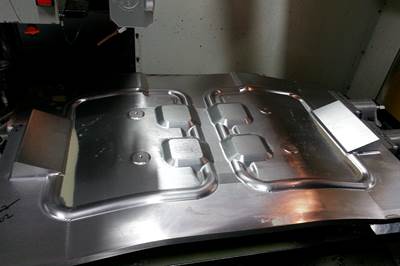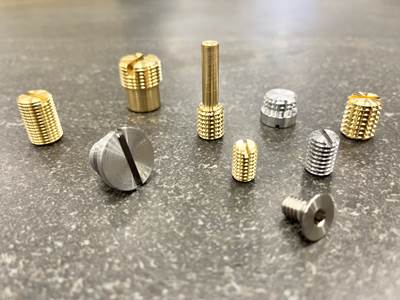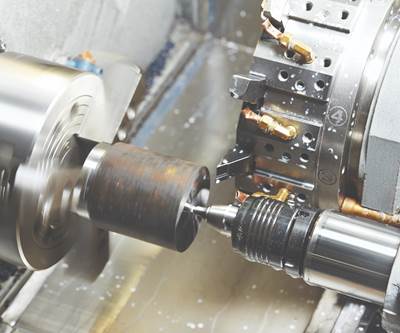Turning Machines
“Turning” defines the work that is traditionally done on a lathe. “Turning centers” is a term sometimes applied to machines with secondary spindles and/or rotating tools for milling and drilling. Another term, “turn/mill or multitasking” describes machines that can be thought of as being just as capable at milling and drilling as they are at turning. Lathes, turning centers and turn-mill machines can have horizontal or vertical spindles, with horizontal being most common. Machines with a vertical spindle are generally called a vertical turret lathe, or VTL. If the workpiece is held from above by the vertical spindle, then this type of turning machine is generally called an inverted vertical lathe.







ESSENTIAL READING
VIEW ALL“Turning” the Tables: 10 Must-Read Articles to Sharpen Your Lathe Game
From complex Swiss-type lathes to turning basics, we’ve rounded up 10 turning articles for both beginners and advanced machinists.
Read More4 Commonly Misapplied CNC Features
Misapplication of these important CNC features will result in wasted time, wasted or duplicated effort and/or wasted material.
Read More4 Tips for Staying Profitable in the Face of Change
After more than 40 years in business, this shop has learned how to adapt to stay profitable.
Read MoreHow to Start a Swiss Machining Department From Scratch
When Shamrock Precision needed to cut production time of its bread-and-butter parts in half, it turned to a new type of machine tool and a new CAM system. Here’s how the company succeeded, despite the newness of it all.
Read MoreBuying a Lathe: The Basics
Lathes represent some of the oldest machining technology, but it’s still helpful to remember the basics when considering the purchase of a new turning machine.
Read MoreThreading On A Lathe
The right choices in tooling and technique can optimize the thread turning process.
Read MoreLatest Turning Machines News And Updates
Gosiger Lathe Optimized for Intricate Parts Production
PMTS 2025: The NN-25UB8K is designed to reduce vibration and thermal displacement, providing consistent, accurate performance even during high-speed operations.
Read MoreStar CNC Swiss-Type Lathe Features Twin-Thread Whirling Unit
PMTS 2025: The SD-26 Type S employs a gate-shaped gang-style tool post including two B-axis stations, which are capable of programmable simultaneous five-axis control.
Read MoreShop Tour Video: Inside a Family-Owned Machine Shop Specializing in High-Precision Plastics
In this episode of “View From My Shop,” East Coast Precision Manufacturing guides us through their plastics job shop. Learn how this shop has quickly and inexpensively built out its shop floor, as well as how it formed a niche for itself during difficult business conditions.
WatchMurata Machinery Turning Machine Features Twin Spindles
PMTS 2025: The MT1065EX twin-spindle CNC turning machine enables intricate operations such as pinch turning and simultaneous first- and second-operation machining.
Read MoreMazak Turning Machine Enables High-Volume Production of Small Parts
PMTS 2025: The Syncrex 38/9 Swiss-type turning machine features a nine-axis configuration that includes five spindle motors.
Read MoreMarubeni Citizen-Cincom Lathe Enables Continuous Operation
PMTS 2025: The BNA-42SY5 lathe features an integrated auto-compensation system to automatically adjust tooling based on measurements taken at the inspection station.
Read MoreFeatured Posts
Finding the Right Tools for a Turning Shop
Xcelicut is a startup shop that has grown thanks to the right machines, cutting tools, grants and other resources.
Read MoreTop Shops: Designing a Shop to Meet Customer Needs
Working closely with customers and making careful investments has enabled this Wisconsin machine shop to tackle difficult jobs with tight deadlines as a core part of its business.
Read MoreThe Human Impact of Machining Technology
SSP’s commitment to adopting the latest machining technology benefits not only the business, but its employees as well.
Read MoreFacilitating Lean Manufacturing Through Modularity
Knowing how to subdivide machines and jobs has enabled Danobat to create a lean manufacturing process that improves its lead times by up to 25%.
Read MoreCustom Motorcycle Parts Made Here: Video Tour of a Family-Owned CNC Machine Shop
Lee Wimmer invited us to tour his second-generation family-owned machine shop in Perkasie, PA. This video explores the production processes behind precision-machined parts for both Wimmer Custom Cycle and LS Wimmer Machine Co., and shows how ingenuity and determination are still at the heart of American manufacturing. Today, both companies are now managed by Wimmer’s three sons.
Watch4 Commonly Misapplied CNC Features
Misapplication of these important CNC features will result in wasted time, wasted or duplicated effort and/or wasted material.
Read MoreFAQ: Turning Machines
What is turning?
Turning is the process of using lathes to remove material from the outer diameter of a rotating workpiece. Single-point tools shear metal from the workpiece in (ideally) short, distinct, easily recyclable chips.
Source: Machining 101: What is Turning?
What is a lathe?
One of the key characteristics of a lathe, unlike a vertical or horizontal milling machine, is that the workpiece turns, as opposed to the tool. Thus, lathe work is often called turning. Turning, then, is a machining process used to make round, cylindrical parts.
Source: Buying a Lathe: The Basics
What is the basic configuration of a lathe?
The basic two-axis lathe consists of a headstock with spindle, chuck for holding the part, lathe bed, carriage and cross-slide, tool turret and tailstock. While most lathes have a moveable tailstock to support the workpiece at the end, away from the chuck, not all machines come with this feature as a standard. A tailstock is particularly useful, however, when the workpiece is relatively long and slender.
Source: Buying a Lathe: The Basics
What kinds of spindles do lathes typically have?
The spindle on a turning center is either belt-driven or direct-drive. Generally, belt-driven spindles represent older technology. They speed up and slow down at a lower rate than direct-drive spindles, which means cycle times can be longer. If you’re turning small-diameter parts, the time it takes to ramp the spindle from 0 to 6,000 rpm is significant. In fact, it might take twice as long to reach this speed than with a direct-drive spindle.
What are the types of programmable tailstocks?
A built-in, numerically controlled tailstock can be a valuable feature for automated processes. A fully programmable tailstock provides more rigidity and thermal stability. However, the tailstock casting adds weight to the machine.
There are two basic types of programmable tailstocks—servo-driven and hydraulic. Servo-driven tailstocks are convenient, but the weight they can hold may be limited. Typically, a hydraulic tailstock has a retractable quill with a 6-inch stroke. The quill also can be extended to support a heavy workpiece, and do so with more force than a servo-driven tailstock can apply.
What are some variations of the basic lathe configuration?
Slant-bed lathes provide a number of advantages, while multitasking lathe configurations might open up possibilities heretofore unthought of.
The slant-bed lathe design is probably the most common and well-known configuration in today’s CNC lathes. Typically, the bed of the lathe slants at a 30- or 45-degree angle, although some 60-degree models also are available.
Multitasking machines are often built on a turning center platform. These machines use rotary tools to combine several cutting processes such as turning, milling, drilling, tapping, grooving, threading and deep-hole boring on one machine.
Source: Buying a Lathe: Slant-Beds and Multitasking Configurations





























